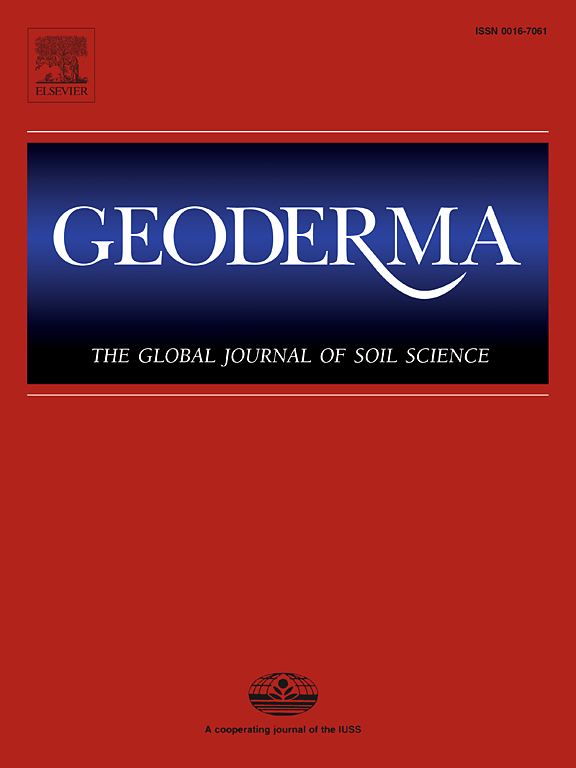当添加不确定的田间纹理估计时,数字土壤制图预测土壤纹理的性能是否有所提高?基于粘土含量的研究
IF 5.6
1区 农林科学
Q1 SOIL SCIENCE
引用次数: 0
摘要
手感土壤质地观测(HFST)不如实验室土壤质地测量(LAST)准确,但数量更多。因此,将LAST和HFST信息同时作为土壤粒径分布数字制图(DSM)的校准数据是很有吸引力的。我们在约6,800平方公里的面积上使用了约1,000个last和15,000个hfst。我们在DSM中纳入了HFST和LAST校准数据的不确定度,并与忽略测量误差的情况进行了比较。我们逐步将HFST校准数据添加到LAST数据中,并对所有实验保持相同的验证集进行预测和k-fold验证。我们根据不同的策略添加hfst:基于LAST-only模型的最不确定预测区域,或基于先前LAST + nHFST模型的最不确定预测区域,或随机添加。我们将讨论这些不同策略的利弊。加入HFST数据为模型校准提供了有用的信息,但前提是考虑了不确定性。不同的hfst添加策略导致不同的不平衡采样、地图和预测区间。我们解释了这些不同的不平衡采样如何锐化或扩大各种粘土含量范围的预测分布。如果hfst的数量过多,则会导致对90%预测区间的过于乐观估计和较大的均匀分布,从而平滑了粘土含量的空间变化。使用权重来增加高功率sts以承认它们的不确定性,这大大提高了DSM的预测,但是高功率sts的数量和增加它们的策略必须仔细调整。本文章由计算机程序翻译,如有差异,请以英文原文为准。
Does digital soil mapping prediction performance of soil texture improve when adding uncertain field texture estimates? A study based on clay content
Hand-feel soil texture observations (HFST) are less accurate, yet much more numerous, than laboratory measurements of soil texture (LAST). Therefore, it is tempting to incorporate both LAST and HFST information as calibration data in digital soil mapping (DSM) of particle-size distribution. We used about 1000 LASTs and 15,000 HFSTs over an area of about 6,800 km2. We incorporated the uncertainties of HFST and LAST calibration data in DSM and compared it with a case where measurement errors were ignored. We added progressively HFST calibration data to LAST data and ran predictions and k-fold validations keeping the same validation set for all experiments. We added HFSTs according to different strategies: either based on the most uncertain predicted areas from the LAST-only model, or those from the preceding LAST + nHFST model, or randomly. We discuss the pros and cons of these different strategies. Adding HFST data brought useful information for model calibration, but only if the uncertainty was accounted for. Various strategies for adding HFSTs led to different unbalanced samplings, maps and prediction intervals. We explain how these various unbalanced samplings sharpened or enlarged the predictive distribution of various clay content ranges. Adding a too large number of HFSTs led to an over-optimistic estimation of the 90 % prediction interval and to large homogeneous patterns, smoothing the spatial variation of clay content. Adding HFSTs using weights to acknowledge their uncertainty substantially improved DSM predictions, but the number of HFSTs and the strategy to add them must be carefully adapted.
求助全文
通过发布文献求助,成功后即可免费获取论文全文。
去求助
来源期刊

Geoderma
农林科学-土壤科学
CiteScore
11.80
自引率
6.60%
发文量
597
审稿时长
58 days
期刊介绍:
Geoderma - the global journal of soil science - welcomes authors, readers and soil research from all parts of the world, encourages worldwide soil studies, and embraces all aspects of soil science and its associated pedagogy. The journal particularly welcomes interdisciplinary work focusing on dynamic soil processes and functions across space and time.
 求助内容:
求助内容: 应助结果提醒方式:
应助结果提醒方式:


